 |
 |
|
 |
Electronic highway signs to turn AMBER during searches for missing children |
 |
 |
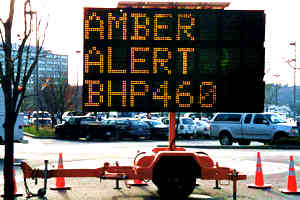 |
Motorists & passengers will see messages like this whenever there’s
an AMBER Alert, complete with suspect’s license plate number such as
the fictitious sample shown above. Photo by Marsha Storck
|
A community full of watching eyes can help parents and police searching for
missing or abducted children, and now that sense of community extends to Minnesota
highways. Last week, Mn/DOT announced that electronic highway signs will help
recruit motorists and passengers whenever an "AMBER Alert" search
begins.
Twenty-six other states use the AMBER Alert system—"America’s Missing:
Broadcast Emergency Response"—to interrupt radio and television broadcasts
with emergency bulletins about missing children. Now Mn/DOT will assist by displaying
brief AMBER Alert bulletins on changeable message signs as well.
"These signs will be a valuable tool in the event that an AMBER Alert
is issued," said Doug Weiszhaar, acting commissioner. "They will prompt
drivers to keep their eyes open for anything suspicious and to turn on their
radios for more information."
Within an hour after an AMBER Alert begins, the state’s Division of Emergency
Management will activate an alert system using radio and television. Stations
will interrupt programming with available information about the victim, the
abductor and the possible vehicles involved, including license plate numbers.
About the same time, Mn/DOT will also display AMBER Alerts on changeable message
signs in a search area designated by the Bureau of Criminal Apprehension. Mn/DOT
has 105 of these signs in use around the state, including 70 in the Twin Cities
metro area and a total of 35 in Detroit Lakes, Duluth, Hibbing, Mankato, Rochester,
St. Cloud and Virginia.
The signs will continue to display the AMBER Alert for five hours or until
the alert is over. If motorists see a vehicle matching the description, they
can call 9-1-1.
"Our changeable message signs are on our most heavily traveled routes,
so many people will see an AMBER Alert message while on the road," Weiszhaar
said. "We could be reaching tens of thousands, maybe hundreds of thousands,
of people at any given time."
The AMBER Alerts will not displace messages that these electronic signs usually
display, according to Weiszhaar. Mn/DOT has used this technology since the mid-1990s
to alert motorists to crashes and other road and traffic conditions up ahead.
The AMBER Alerts are an exception to the rule because of their importance, Weiszhaar
said.
"When a stranger abducts a child, time is the greatest enemy," he
said. "That’s why it is so important to use every resource available and
enlist the help of every citizen possible."
By Marsha Storck
|
back

|
 |
Renovated Hanley Falls to Norwood rail line provides option for shippers |
 |
 |
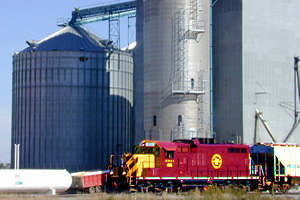 |
A Minnesota Prairie Line train pulls onto the main line after adding
a carload of grain at a Fairfax elevator. Twin Cities and Western
Railroad photo
|
The Minnesota Prairie Line recently began operating between Hanley Falls and
Norwood supported with funding from a state loan program coordinated by the
Office of Freight, Railroads and Waterways. Shippers can now use the rehabilitated
track instead of trucks to move grain, fertilizer, rock and kaolin clay.
"The Minnesota Prairie Line offers another transportation choice for regional
shippers," said Al Vogel, Freight, Railroads and Waterways director.
Mn/DOT, the Minnesota Valley Regional Railroad Authority and the MINNRAIL Shippers
Association worked together on the $6 million project. A loan from the Minnesota
Rail Improvement Program loan provided $4.8 million to help fund it. The shippers
and the Minnesota Valley Regional Rail Authority each contributed $600,000.
Project supporters expect an average of one train per day will use this 94.5
mile-long route during its first phase of operation, adding up to about 8,200
cars per year. The amount of freight in these cars would require using nearly
33,000 semi-trailer trucks a year if shipped by highway, Vogel said.
The new rail service is the 22nd regional line rehabilitated by the Minnesota
Rail Service Improvement Program since it was began in 1976. Cities along the
Minnesota Prairie Line’s route also include Redwood Falls, Morton, Franklin,
Fairfax, Gibbon, Winthrop, Gaylord, Arlington, Green Isle, Hamburg and Young
America.
By Sue Stein
|
back

|
 |
Crossing deaths spur warnings about railroad safety |
 |
 |
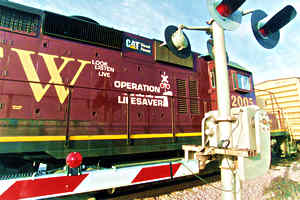 |
A Twin Cities and Western locomotive bearing the Operation Lifesaver
message rolls through a railroad crossing west of the Twin Cities.
Staff Photo
|
The reintroduction of freight service on the renovated 94.5-mile rail line
between Hanley Falls and Norwood underscores the need for motorists and pedestrians
to use extra caution and common sense at railroad crossings.
So far this year, 19 people have died in rail crossing and trespassing incidents.
Ten pedestrians were killed when struck by trains and nine people died when
vehicles in which they were riding collided with trains. In 2001, a total of
four people died in vehicle/train crashes. Ten people died in pedestrian-related
incidents last year.
The Hanley Falls to Norwood route now operated by the Minnesota Prairie Line
includes 104 at-grade crossings. Statewide, there are more than 4,600 public
and private crossings.
Addressing the new rail service, Al Vogel, director Freight, Railroads and
Waterways, said, "There haven’t been trains running on this line for more
than two years which means drivers may not be looking for trains. Now there
are 104 new locations where trains and vehicles could collide. We want people
to know that any time is ‘train time.’"
Mn/DOT works with Operation Lifesaver to promote rail-crossing safety including
free educational programs for schools and community groups. For more information,
see the Operation Lifesaver Web site at: http://www.mnsc.org/ontheroadway/ol/index.htm.
By Craig Wilkins
|
back

|
 |
Briefing the new boss: Staff assembles information for future commissioner, legislators |
 |
 |
Orientation is a must for all new employees these days, but one soon-to-be-appointed
employee—the yet-to-be-named new Mn/DOT commissioner—will need more than just
the standard half-day session.
To prepare for the new commissioner’s arrival, Mn/DOT managers, district engineers
and other staff are assembling and summarizing key documents that provide an
overview about Mn/DOT, its business and the issues the department faces. The
information is assembled into segments that correspond to what Mn/DOT’s new
administration needs to know in its first seven, 30 and 60 days in office.
Information in the packet will range from the basic (parking, keys) to the
complex (revenue and expenditures) and include:
-
Overviews of recent studies and market research
-
Planning documents such as the 20-year statewide transportation plan and
the Department business plan
-
Mn/DOT operations (e.g., programming highway projects, security)
-
Moving Minnesota status
-
Construction updates (light rail transit, design-build, intelligent transportation
systems) and
-
An update on Mn/DOT’s workforce, such as its efforts for succession planning,
strategic staffing and recruitment.
In addition to the information packet for the new commissioner, a briefing
packet specifically aimed at legislators is also in development. The Government
Relations staff is preparing a packet that includes:
Government Relations and district management staff will also meet with legislators
by Mn/DOT district, beginning with Willmar/District 8 on Nov. 26.
Information from both briefing packets will be available soon on Mn/DOT’s Web
site.
|
back

|
 |
Virginia’s Frederickson named winter maintenance coordinator |
 |
 |
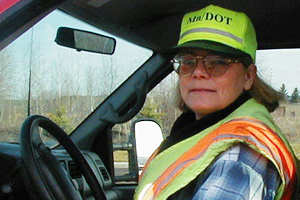 |
Wendy Frederickson was appointed as Mn/DOT’s new winter maintenance
coordinator. Photo by Dick Maddern
|
The Office of Maintenance Operations and Research appointed Wendy Frederickson
as its new winter maintenance coordinator. The position previously was known
as the Salt Solutions coordinator.
Before accepting her new position, Frederickson worked as a transportation
generalist at the Virginia Truck Station in the Duluth District.
"I’ve worked for Mn/DOT for nearly 12 years, and I’ve seen the Salt Solutions
Program develop from its infancy. I know from experience that it’s a great program,
and I’m excited to get more involved with it," said Frederickson.
Frederickson’s responsibilities include the duties once held by the salt solutions
coordinator, whose principal task included coordinating statewide initiatives
to reduce salt use.
"In this position I will be able to research and investigate new ideas
about to snow and ice operations," Frederickson said, "so that continuous
education and technology are incorporated into the Salt Solutions program and
will save time and money for the department."
Rick Shomion, training coordinator,maintenance operations, said, "We renamed
the position because the job now encompasses a variety of duties. The winter
maintenance coordinator will not only oversee the salt solutions program, but
will also be responsible for incorporating the Road/Weather Information System
into the program, managing de-icing and anti-icing guidelines, updating data,
writing reports and newsletters and much more."
Frederickson’s new position requires her to provide training and technical
expertise to all Mn/DOT snowplow operators as well as present current snow and
ice control procedures.
"The speaker’s bureau gave me the opportunity to educate students, adults
and community groups about winter driving and snowplow safety," Frederickson
added. "So it comes down to helping the public stay safe. With this job,
I’ll be able to do that and much more."
"Wendy is actively involved with the Work Zone Safety Speakers Bureau
Program, which makes her an excellent choice for the job," Shomion said.
"I’m looking forward to the enthusiasm she’ll bring to this position."
By Daneeka Marshall-Oquendo
|
back

|
 |
Innovations on I-90 promise safer winter travel for motorists |
 |
 |
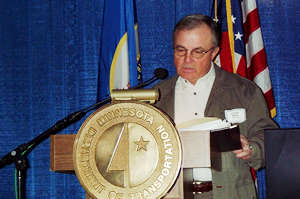 |
During the Minnesota Intelligent Transportation System meeting in Jackson,
George Welk, assistant district engineer, Mankato/District 7, reviewed
advanced technology for improving highway safety. Photo by Rebecca
Arndt
|
Two innovations—remotely operated bridge anti-icers and gates that limit freeway
access—promise safer travel for motorists on I-90 this winter.
Prevent ice from forming
Bridges on I-90 at Worthington and Beaver Creek now have automated anti-icing
systems that spray the bridge surface with chemicals such as potassium chloride
to prevent ice formation.
These anti-icing systems are located at the freeway’s junctions with Hwy 60
in Worthington and with Rock County Hwy 4 near Beaver Creek. Pavement sensors
monitor when road surface conditions get near the freezing point. Within minutes,
36 to 40 nozzles mounted along the bridge guardrails spray chemicals onto the
freeway surface.
"Overpasses are the first spot on the road to freeze and they can freeze
in minutes," said Dough Weiszhaar, acting commissioner. "This anti-icing
system allows us to act before ice has a chance to form."
The overpasses at Beaver Creek and Worthington record an average of 12 snow-
and ice-related crashes every year.
In addition to the bridges on I-90, Mn/DOT operates anti-icing or de-icing
systems on bridges in the Twin Cities metro area, Duluth, Dresbach and Winona.
Automatically close I-90 during severe weather
Mn/DOT will test another innovation this year on I-90 at the freeway’s interchange
with Hwy 71 near Jackson.
During severe weather, district maintenance crews can now remotely activate
gates that block access to I-90. This enables them to close access almost instantly
and gvies them more time to clear the freeway. Closed gates also reduce the
opportunity for motorists to enter the freeway, where their presence can impede
efforts to keep it passable.
The remotely operated gates evolved from manually operated gates that have
successfully helped Mn/DOT deter traffic from entering freeways during severe
storms.
"These automated gates save about 15 percent in the cost to clear the
roads," Weiszhaar said. "Fewer employees are needed to clear the interstate
which means more employees can focus on clearing the road."
By Craig Wilkins
|
back

|
 |
Office of Research Services joins Program Delivery Group |
 |
 |
In order to improve service delivery, the Office of Research Services joined
the Program Support Group effective Nov. 12. Previously, the office reported
directly to Mn/DOT’s chief of staff.
Doug Weiszhaar, acting commissioner, said the change results from Mn/DOT’s
efforts to identify the most effective way to deliver the department’s products
and services. Weiszhaar added that Research Services staff will continue to
shape the state’s transportation system by acquiring, creating and sharing transportation
research and knowledge.
As an expert office within the Program Support Group, the staff will identify
research needs and manage state and national research. The Mn/DOT Library will
continue to provide reference assistance, document delivery and interlibrary
loans.
Dave Johnson continues serving as acting director of Research Services.
By Craig Wilkins
|
back

|
 |
Newsline now offers round-up of recent Mn/DOT news releases |
 |
 |
Mn/DOT Newsline begins a new service: highlighting news releases issued
by the department to the public via the news media. These are some of the news
releases issued this week:
For more news releases, go to http://www.dot.state.mn.us
Clippings are available on-line at: http://www2.dot.state.mn.us/ocpr/clips.html.
|
back

|
 |
New North Star Web site makes finding state services easier |
 |
 |
A new and improved state Web site went online Nov. 18. The revised North Star
site organizes government services by theme rather than by agency.
The themes—living and working, learning and education, health and safety, government,
business, travel and leisure, and environment—were chosen to help break down
barriers people face when doing business with their government. The theme-based
structure means citizens and customers no longer need to be familiar with state
government to find specific information or services.
The new site is the result of more than a year of work by the Office of Technology
and InterTechnologies Group in the Department of Administration plus more than
250 providers of state government services.
The North Star site receives an average of 1.2 million visits monthly. The
site will evolve as customers explore it. Check it out at http://www.state.mn.us.
If you have comments about Mn/DOT content on the site, contact Kay Korsgaard,
Office of Communications and Public Relations, 651/297-1919.
By Kay Korsgaard
|
back

|
 |
|
 |



